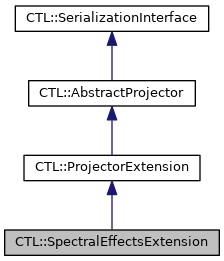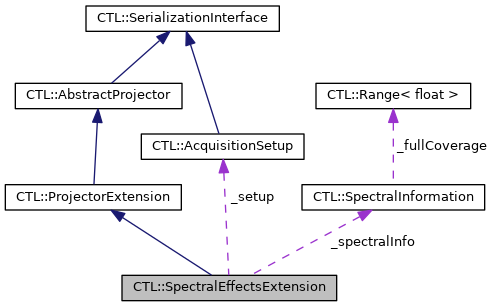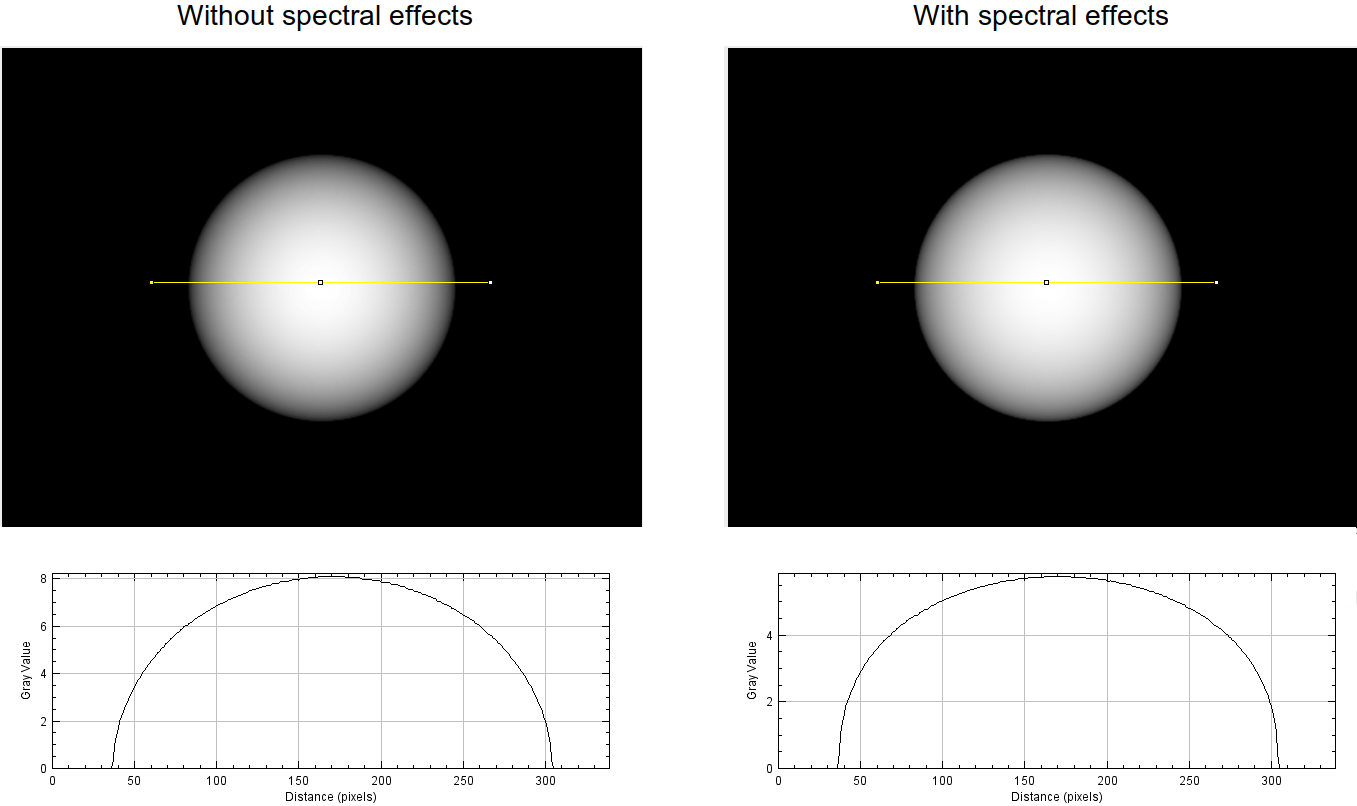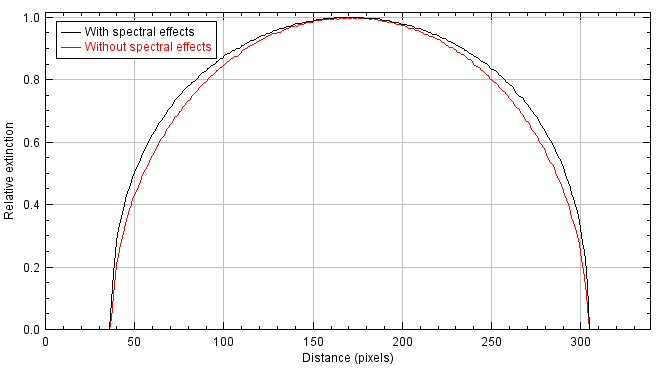The SpectralEffectsExtension class is an extension for forward projectors that provides functionality to consider spectral effects. More...
#include <spectraleffectsextension.h>


Public Types | |
| enum | { Type = 104 } |
 Public Types inherited from CTL::ProjectorExtension Public Types inherited from CTL::ProjectorExtension | |
| enum | { Type = 100 } |
 Public Types inherited from CTL::AbstractProjector Public Types inherited from CTL::AbstractProjector | |
| enum | { Type = 0 } |
 Public Types inherited from CTL::SerializationInterface Public Types inherited from CTL::SerializationInterface | |
| enum | { Type = -1, UserType = 65536 } |
Public Member Functions | |
| int | type () const override |
| void | configure (const AcquisitionSetup &setup) override |
| ProjectionData | project (const VolumeData &volume) override |
| SpectralEffectsExtension (float energyBinWidth) | |
| ProjectionData | projectComposite (const CompositeVolume &volume) override |
| ProjectionData | projectSparse (const SparseVoxelVolume &volume) override |
| Provides the functionality to forward project SparseVoxelVolume data. More... | |
| bool | isLinear () const override |
| QVariant | toVariant () const override |
| Stores the contents of this instance in a QVariant. More... | |
| QVariant | parameter () const override |
| void | setParameter (const QVariant ¶meter) override |
| Sets the parameters of this instance based on the passed QVariant parameter. Parameters need to follow the naming convention as described in parameter(). More... | |
| void | setSpectralSamplingResolution (float energyBinWidth) |
| ProjectorExtension (AbstractProjector *projector=nullptr) | |
| ProjectorExtension (std::unique_ptr< AbstractProjector > projector) | |
 Public Member Functions inherited from CTL::ProjectorExtension Public Member Functions inherited from CTL::ProjectorExtension | |
| ProjectorExtension (AbstractProjector *projector=nullptr) | |
| ProjectorExtension (std::unique_ptr< AbstractProjector > projector) | |
| virtual void | use (AbstractProjector *other) |
| void | use (std::unique_ptr< AbstractProjector > other) |
| void | fromVariant (const QVariant &variant) override |
| Sets the contents of the object based on the QVariant variant. More... | |
| AbstractProjector * | release () |
| void | reset () |
 Public Member Functions inherited from CTL::AbstractProjector Public Member Functions inherited from CTL::AbstractProjector | |
| AbstractProjector (const AbstractProjector &)=delete | |
| AbstractProjector (AbstractProjector &&)=default | |
| AbstractProjector & | operator= (const AbstractProjector &)=delete |
| AbstractProjector & | operator= (AbstractProjector &&)=default |
| ~AbstractProjector () override=default | |
| ProjectionData | configureAndProject (const AcquisitionSetup &setup, const VolumeData &volume) |
| Performs a forward projection with a precedent configuration of the projector. More... | |
| ProjectionData | configureAndProject (const AcquisitionSetup &setup, const CompositeVolume &volume) |
| Performs a forward projection with a precedent configuration of the projector. More... | |
| ProjectionData | configureAndProject (const AcquisitionSetup &setup, const SparseVoxelVolume &volume) |
| Performs a forward projection with a precedent configuration of the projector. More... | |
| virtual ProjectorNotifier * | notifier () |
| Returns a pointer to the notifier of the projector. More... | |
| void | connectNotifierToMessageHandler (bool includeProgress=false) |
| Connects the notifier to the CTL's MessageHandler. More... | |
 Public Member Functions inherited from CTL::SerializationInterface Public Member Functions inherited from CTL::SerializationInterface | |
| virtual | ~SerializationInterface ()=default |
Private Types | |
| using | BinInformation = SpectralInformation::BinInformation |
Private Member Functions | |
| void | updateSpectralInformation () |
| bool | canBypassExtension (const CompositeVolume &volume) const |
| void | applyDetectorResponse (ProjectionData &intensity, float energy) const |
| ProjectionData | projectLinear (const CompositeVolume &volume) |
| ProjectionData | projectNonLinear (const CompositeVolume &volume) |
| ProjectionData | singleBinIntensityLinear (const std::vector< ProjectionData > &materialProjs, const std::vector< float > &massAttenCoeffs, const BinInformation &binInfo) |
| ProjectionData | singleBinIntensityNonLinear (const CompositeVolume &volume, const BinInformation &binInfo) |
| void | addDummyPrepareSteps () |
| void | removeDummyPrepareSteps () |
| void | replaceDummyPrepareSteps (const BinInformation &binInfo, float binWidth) |
Private Attributes | |
| SpectralInformation | _spectralInfo |
| AcquisitionSetup | _setup |
| A copy of the setup used for acquisition. | |
| float | _deltaE { 0.0f } |
Friends | |
| template<class > | |
| struct | SerializationHelper::RegisterWithSerializationHelper |
Additional Inherited Members | |
 Protected Member Functions inherited from CTL::ProjectorExtension Protected Member Functions inherited from CTL::ProjectorExtension | |
| virtual ProjectionData | extendedProject (const MetaProjector &nestedProjector) |
 Protected Member Functions inherited from CTL::SerializationInterface Protected Member Functions inherited from CTL::SerializationInterface | |
| SerializationInterface ()=default | |
| SerializationInterface (const SerializationInterface &)=default | |
| SerializationInterface (SerializationInterface &&)=default | |
| SerializationInterface & | operator= (const SerializationInterface &)=default |
| SerializationInterface & | operator= (SerializationInterface &&)=default |
 Related Functions inherited from CTL::ProjectorExtension Related Functions inherited from CTL::ProjectorExtension | |
| std::unique_ptr< ProjectorExtensionType > | makeExtension (AbstractProjector *projector=nullptr) |
| std::unique_ptr< ProjectorExtensionType > | makeExtension (std::unique_ptr< AbstractProjector > projector) |
 Related Functions inherited from CTL::AbstractProjector Related Functions inherited from CTL::AbstractProjector | |
| VolumeData | |
| Alias name for CTL::SpectralVolumeData. More... | |
| std::unique_ptr< ProjectorType > | makeProjector (ConstructorArguments &&... arguments) |
Detailed Description
The SpectralEffectsExtension class is an extension for forward projectors that provides functionality to consider spectral effects.
This extension adds the functionality to consider spectral effects within the projections. These effects encompass:
- spectrally-dependent radiation output (polychromatic spectrum)
- spectrally-dependent attenuation coefficients
- (spectral) detector response function/model
Generally speaking, this extension sub-divides the projection task into multiple subtasks, each representing a single energy bin, for within which monoenergetic behavior (corresponding to the bin energy) is assumed. Depending on whether the nested projector routine is linear or not, the actual performed procedure differs. More detailed information is provided in project() and projectComposite().
Meaningful results are achieved only if this extension is used in combination with volume data that contains full spectral information (see SpectralVolumeData::hasSpectralInformation()). In case volume data without spectral information is used, this extension will be bypassed (Note that the combination of non-spectral volume data with a detector component that has explicitely being assigned a spectral response model is contradictory, and consequently an exception will be thrown).
The difference between projections with and without spectral effects in the example above is shown here:

The following plot shows a comparison of the normalized absorption profiles shown in the figures above.

Constructor & Destructor Documentation
◆ SpectralEffectsExtension()
|
explicit |
Constructs a SpectralEffectsExtension and sets the bin width for sub-sampling of the spectral range to energyBinWidth (in keV). If energyBinWidth = 0, the energy bin width will be determined using the information received from AbstractSource::spectrumDiscretizationHint() of the source component in the setup provided to configure().
Member Function Documentation
◆ addDummyPrepareSteps()
|
private |
Adds dummy prepare steps (of type prepare::SourceParam) to the setup. Those are later used to adjust the energy range and the flux of the system for the currently processed energy bin.
- See also
- replaceDummyPrepareSteps().
◆ applyDetectorResponse()
|
private |
Processes projection data in intensity (corresponding to the radiation energy energy) to account for spectral detector response. For that, each intensity value is multiplied by the detector response for energy energy.
◆ canBypassExtension()
|
private |
Returns true if no spectral effects need to be considered, i.e. neither the detector nor any of the subvolumes in volume have spectral information. This function throws an exception if the detector has a spectral response model and not all the subvolumes in volume have spectral information. In any other case than the aforementioned, false is returned.
◆ configure()
|
overridevirtual |
This overrides the configure() method and calls the configure method of the nested projector object.
Re-implement this method to retrieve all information required for the purpose of the desired extension. Make sure to delegate this call to the base class (ProjectorExtension) at the end of the method.
Throws std::runtime_error if the nested projector object is unset.
Reimplemented from CTL::ProjectorExtension.
◆ isLinear()
|
overridevirtual |
Returns false, because spectral effects are non-linear (summation in intensity domain).
Reimplemented from CTL::ProjectorExtension.
◆ parameter()
|
overridevirtual |
Returns the parameters of this instance as QVariant.
This returns a QVariantMap with one key-value-pair: ("Sampling resolution", _deltaE), which represents the energy resolution (in keV per bin) used for sampling of spectral effects:
This method is used within toVariant() to serialize the object's settings.
Reimplemented from CTL::AbstractProjector.
◆ project()
|
overridevirtual |
Computes projections of volume considering spectral effects, by means of creating individual projections for a number of energy bins and averaging the results in intensity domain.
For a specific pixel, computation of the extinction value can be expressed as:
\( \begin{align*} \epsilon & =\ln\frac{I_{0}}{\sum_{E}i_{0}(E) \exp\left[-m(E)\mathcal{F}_{\textrm{linear}}(\rho)\right]}\\ \epsilon & =\ln\frac{I_{0}}{\sum_{E}i_{0}(E) \exp\left[-\mathcal{F}_{\textrm{non-linear}}(m(E)\cdot\rho)\right]}, \end{align*} \)
depending on whether the nested projector of this instance is linear ( \(\mathcal{F}_{\textrm{linear}}\), upper row) or not ( \(\mathcal{F}_{\textrm{non-linear}}\), bottom row). Here, \(i_{0}(E)\) denotes the initial intensity of energy \(E\), \(m(E)\) is the energy-dependent mass attenuation coefficient of the material, and \(\rho\) is the material density (3D voxelized data); \(I_{0}\) denotes the total intensity. As can be seen from the equations, in case of a linear nested projector, it is sufficient to forward project the material density, thus only a single projection operation is required.
Reimplemented from CTL::ProjectorExtension.
◆ projectComposite()
|
overridevirtual |
Computes projections of the composite volume volume considering spectral effects, by means of creating individual projections for a number of energy bins and averaging the results in intensity domain.
For a specific pixel, computation of the extinction value can be expressed as:
\( \begin{align*} \epsilon & =\ln\frac{I_{0}}{\sum_{E}i_{0}(E) \exp\left[-\sum_{k}m_{k}(E)\mathcal{F}_{\textrm{linear}}(\rho_{k})\right]}\\ \epsilon & =\ln\frac{I_{0}}{\sum_{E}i_{0}(E) \exp\left[-\sum_{k}\mathcal{F}_{\textrm{non-linear}}(m_{k}(E)\cdot\rho_{k})\right]}\\ \end{align*} \)
depending on whether the nested projector of this instance is linear ( \(\mathcal{F}_{\textrm{linear}}\), upper row) or not ( \(\mathcal{F}_{\textrm{non-linear}}\), bottom row). Here, \(i_{0}(E)\) denotes the initial intensity of energy \(E\), \(m_{k}(E)\) is the energy-dependent mass attenuation coefficient of material \(k\), and \(\rho_{k}\) its material density (3D voxelized data); \(I_{0}\) denotes the total intensity. As can be seen from the equations, in case of a linear nested projector, it is sufficient to forward project the material densities of all materials, thus only a single projection operation per sub-volume in volume is required. Note that this might result in substantial memory requirement.
Reimplemented from CTL::ProjectorExtension.
◆ projectLinear()
|
private |
Computes the projections from volume with a linear nested projector.
The internal workflow is as follows:
- Compute forward projections of the material density of all subvolumes in volume.
- For each energy bin: compute intensity using singleBinIntensityLinear() and add result to total sum.
- Transform final result to extinction domain.
◆ projectNonLinear()
|
private |
Computes the projections from volume with a non-linear nested projector.
The internal workflow is as follows:
- Add dummy prepare steps to the setup (later used to adjust system for the energy bin).
- For each energy bin: compute intensity using singleBinIntensityNonLinear() and add result to total sum.
- Transform final result to extinction domain.
- Remove dummy prepare steps to restore original setup.
◆ ProjectorExtension() [1/2]
|
explicit |
Constructs a ProjectorExtension object and sets the nested projector to projector. The nested projector is internally used as a basis for computing forward projections. Note that the constructed object takes over the ownership of projector.
◆ ProjectorExtension() [2/2]
|
explicit |
Constructs a ProjectorExtension object and sets the nested projector to projector. A good practice to create a ProjectorExtension on the heap is to use the make function makeExtension(std::unique_ptr<AbstractProjector> projector) which will interally use this constructor.
◆ projectSparse()
|
overridevirtual |
Provides the functionality to forward project SparseVoxelVolume data.
This method takes a sparse dataset volume and returns the full set of forward projections according to the AcquisitionSetup set in the configure() step.
By default, this method performs converts volume to a regular VoxelVolume<float> and calls project() with it. Re-implement this method in sub-classes if you can provide more efficient ways of forward projecting sparse data.
If you intend to call configure() and projectSparse() directly after each other, you should use configureAndProject() instead.
Reimplemented from CTL::ProjectorExtension.
◆ removeDummyPrepareSteps()
|
private |
Removes all dummy prepare steps added by addDummyPrepareSteps(). Must not be called if addDummyPrepareSteps() has not been called earlier.
◆ replaceDummyPrepareSteps()
|
private |
Replaces the dummy prepare steps (see addDummyPrepareSteps()) in the setup to adjust the energy range and the flux of the system for the currently processed energy bin (as specified by binInfo).
◆ setParameter()
|
overridevirtual |
Sets the parameters of this instance based on the passed QVariant parameter. Parameters need to follow the naming convention as described in parameter().
This method is used within fromVariant() to deserialize the object's settings. Direct use of this method is discouraged; consider using dedicated setter methods instead.
Reimplemented from CTL::AbstractProjector.
◆ setSpectralSamplingResolution()
| void CTL::SpectralEffectsExtension::setSpectralSamplingResolution | ( | float | energyBinWidth | ) |
Sets the energy resolution for sampling of spectral effects to energyBinWidth (in keV). This represents the bin width used for (spectrally) sub-sampling the projections. If energyBinWidth = 0, the energy bin width will be determined using the information received from AbstractSource::spectrumDiscretizationHint() of the source component in the setup provided to configure().
◆ singleBinIntensityLinear()
|
private |
Computes the intensity image for a specific energy bin (as specified by binInfo) based on the precomputed forward projections of material densities (materialProjs) and the specific mass attenuation coefficients massAttenCoeffs for the particular energy bin (one value for each material, i.e. materialProjs.size() == massAttenCoeffs.size()).
The internal workflow is as follows:
- For each material: compute product of projection and corresponding attenuation coefficient and sum up results
- Transform final sum to intensity domain (based on intensity data from binInfo).
- Apply (spectral) detector response (see applyDetectorResponse()).
In case the total intensity of the energy bin is zero, the bin will be skipped and a zero image is returned.
◆ singleBinIntensityNonLinear()
|
private |
Computes the projection intensity image of the volume data in volume for a specific energy bin (as specified by binInfo).
The internal workflow is as follows:
- For each material: compute forward projection of the attenuation data for the specific energy bin (see SpectralVolumeData::muVolume()) and sum up results.
- Transform final sum to intensity domain (based on intensity data from binInfo).
- Apply (spectral) detector response (see applyDetectorResponse()).
In case the total intensity of the energy bin is zero, the bin will be skipped and a zero image is returned.
◆ toVariant()
|
overridevirtual |
Stores the contents of this instance in a QVariant.
Implementation of the serialization interface. Stores the object's type-id (from SerializationInterface::toVariant()).
This method uses parameter() to serialize class members.
Reimplemented from CTL::ProjectorExtension.
◆ type()
|
inlineoverridevirtual |
Returns the type-id of the serializable object. Used in deserialization to determine the proper object type.
Add derived classes to the enumeration using the CTL_TYPE_ID macro.
Reimplemented from CTL::ProjectorExtension.
◆ updateSpectralInformation()
|
private |
Causes an update of the spectral information to take place.
- See also
- RadiationEncoder::spectralInformation().
The documentation for this class was generated from the following files:
- modules/src/projectors/spectraleffectsextension.h
- modules/src/projectors/spectraleffectsextension.cpp
 1.8.16
1.8.16